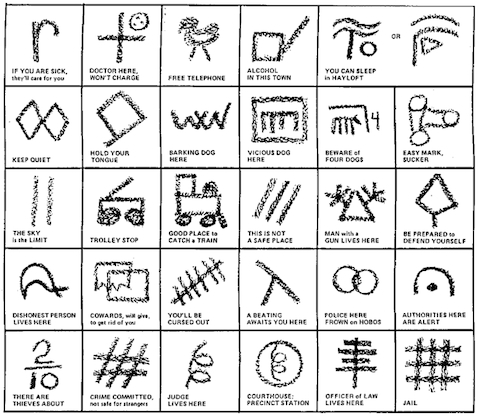
The great industrial designer Henry Dreyfuss is the man most responsible for preserving the art of hobo signs, which he chronicled in his 1972 masterwork Symbol Sourcebook. A good three decades after the end of the Great Depression, Dreyfuss tracked down the backstories for 60 of these signs, which hobos used to tip off their fellow vagabonds. What is most fascinating about these pictograms is that they were universally understood by a population that had no way to act in concert. As the brilliantly named hobo-ologist Jules J. Wanderer noted in his 2001 paper “Embodiments of bilateral asymmetry and danger in hobo signs,” one way these signs worked was by tapping into the American brain’s natural bias for right over left:
For example, paths, roads, or trails were not marked with words indicating they were ‘preferred directions’ to travel or places to be ‘avoided.’ Instead objects were marked with hobo signs that discursively differentiate paths and roads by representing them in terms of bilateral asymmetry, with right-handed directions, as convention dictates, preferred over those to the left.
Note that I said “American brain.” I wonder if Japanese hobos would have come up with signs that oriented in the opposite direction, based on how their written language is arranged.
(h/t Jordan for passing along Wanderer’s paper)


Chris Labarthe // Jun 22, 2012 at 3:02 pm
I am totally going to title my first album “A Beating Awaits You Here.”
Brendan, would that be “hobo-ologist,” or “hobographer”? Speaking of which, this is my favorite “hobo-” joke of all time:
http://www.condenaststore.com/-sp/Hobophobe-New-Yorker-Cartoon-Prints_i8545111_.htm
Brendan I. Koerner // Jun 22, 2012 at 3:11 pm
@Chris Labarthe: Hobos have provided rich material to humorists for quite a while now. John Hodgman’s list of hobo names springs to mind. Plus there’s the whole “killed a hobo” meme.
Alex Benson // Jun 23, 2012 at 11:38 am
ok, so this is officially my favorite Microkhan post ever…
The Hieroglyphics of Vagabonds | Microkhan by Brendan I. Koerner // Feb 12, 2013 at 11:06 am
[…] summer we marveled at the complexity of hobo pictographs, which we took to be a uniquely American phenomenon. But as […]